#MUSEUMS
Explore tagged Tumblr posts
Text
Well, I know where @spikewriter needs to go on her next trip to the UK.
You guuuuuys, you are going to be. So. Jealous. Of what I did today
So Amgueddfa Cymru is the umbrella super museum in Wales, and it is in charge of multiple museums around the country. Seven branches specifically. Entry to each is free, and each commemorates a different facet of Welsh history and culture; of the seven, I had (until a few hours ago) been to five. I've done Caerleon Roman Museum and Amphitheatre, Cardiff Museum, St Ffagan Folk Museum of Welsh Life, Big Pit Coal Mining Museum, and Swansea Waterfront Museum. I have yet to do the Slate Museum in Eryri.
And today, I went to:
The National Wool Museum
YEAH THAT'S RIGHT we have a national wool museum. It's so cool. We arrived at lunchtime so we started in the cafe and we had soup and also cheese and leek Welsh cakes. Except the soup was so Welsh it was correctly served with a piece of cheese:
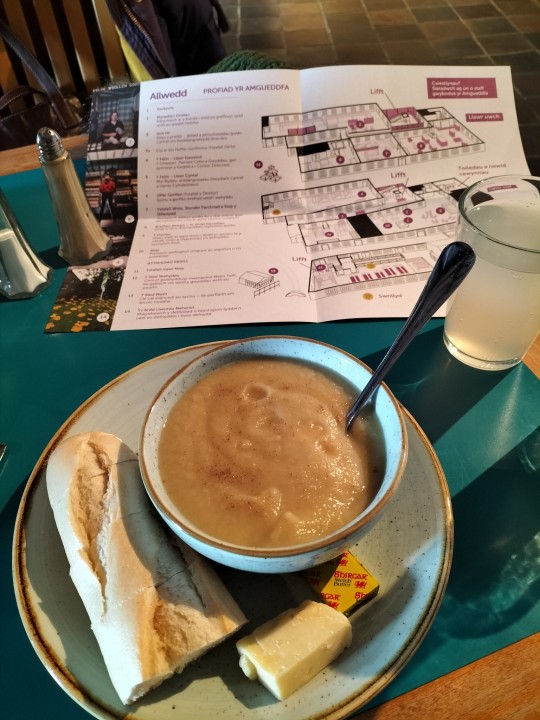
AS IT SHOULD
Anyway, the building was a wool mill once upon a time, and half of the machinery still works, and still produces 100% woollen textiles. Also they run workshops for knitting and weaving and stuff. But you follow the rooms around and they show you the full process, from fleece to flannel.
BUT ALSO at each stop they had little stands where you could try a bit for yourselves. So for example, there was an exhibit where you could card fleece by hand, with a pile of washed fleece beside, and you could just... go ham with the carding.
I deliberately tried not to photograph literally everything. But here's a lil collection:
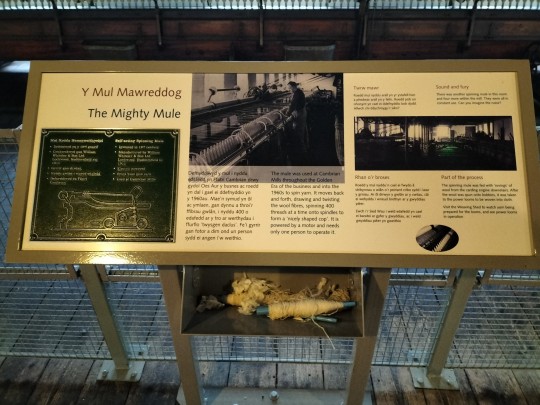
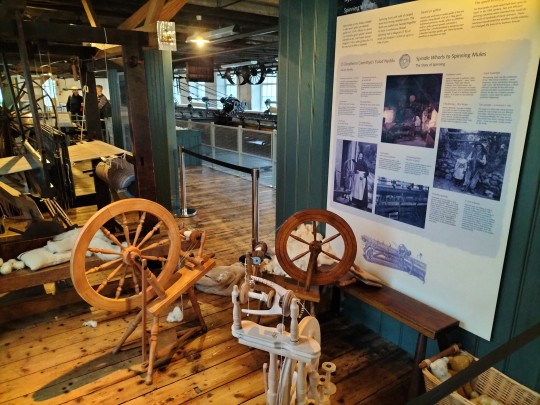
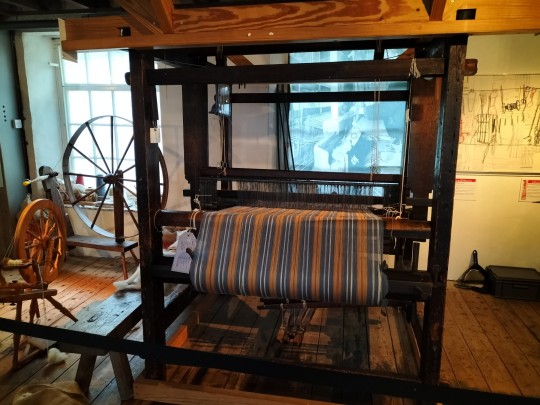
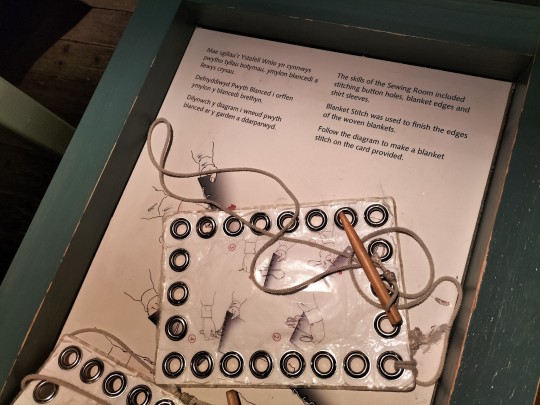
I should have taken a picture of the carding, actually, that was my favourite.
OH MY GOD YEAH and also, they had a section on the uses of the wool. A whole display of traditional Welsh blankets, trad and modern clothes, and, of course, instructions for how to cwtch a baby in a shawl, which was so lovely because that's what my Welsh paternal grandmother taught my English mother to do with me as a baby.

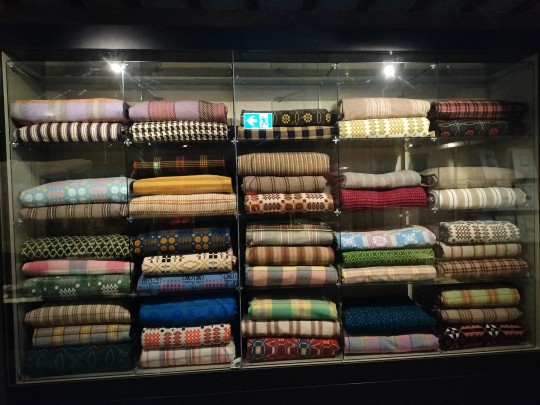
Anyway, then the gift shop sold balls of 100% wool in many fun colours, and tabletop looms, and books on how to knit/weave, and bags of roving that you could spin yourself, and plushie sheep and dragons. And Welsh blankets and shawls/scarves and that.

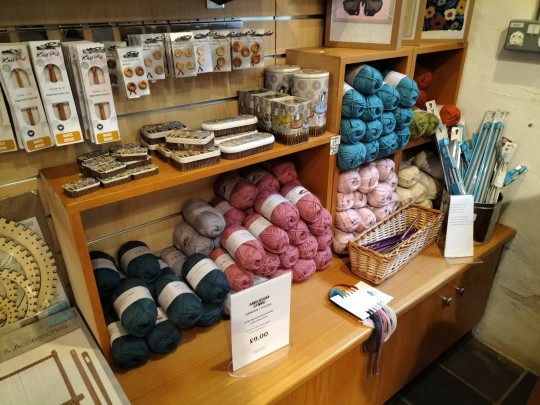
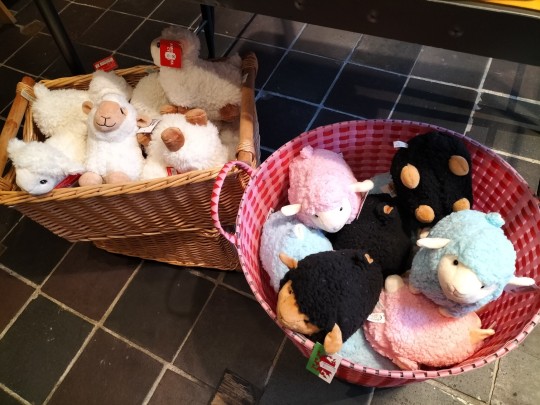
Anyway, you lot are textile nerds. You should all go. It's in the tiniest village in Ceredigion and it is the BEST.
4K notes
·
View notes
Text
Heritage News of the Week
Discoveries!
A runic inscription on one of the Galloway hoard’s elaborately decorated arm rings has been deciphered
Carbon dating puts Saskatchewan Indigenous archaeological site at almost 11,000 years old
A piece of charcoal unearthed at a Saskatchewan archaeological site and tested in a lab suggests the site is 11,000 years old and was likely used as a long-term settlement by Indigenous people.
World's largest-ever bead stash found in 5,000-year-old 'Ivory Lady' tomb in Spain
More than a quarter million beads found in a tomb with female skeletons were used to decorate the women's ceremonial dresses, suggesting they were powerful leaders five millennia ago.
Painted tomb uncovered in Etruscan necropolis
Inside the tomb are frescoes depicting scenes of dancing and ancient workshops, which archaeologists have dated to the mid-5th century BC.
Fragments of the world’s oldest known rune stone discovered in Norway
Archaeologists have found fragments of the world’s oldest known rune stone at the Svingerud burial field in Norway and fitted them together like pieces of a jigsaw puzzle.
Researchers get a peek inside another Herculaneum scroll that survived Vesuvius’s eruption
Researchers have been able to generate an image of text from inside a scroll that was buried in ash with the ancient city of Herculaneum by the eruption of Mount Vesuvius that also destroyed Pompeii—a major breakthrough in deciphering its contents. The first word found on the scroll is "disgust."
Carbonized scroll from Herculaneum really capturing the mood
Fresco reveals Islamic tent in medieval Christian worship
A 13th-century fresco in Ferrara, Italy, provides a rare example of medieval churches using Islamic tents to veil high altars.
7,000-year-old bone holds 3 arrowheads with mixed poisons — the oldest of their kind on record
This is the oldest confirmed use of a mixture comprising two or more plant toxins specifically applied to arrowheads.
Excavations planned in the ancient city of Sebastopolis
The latest excavations are currently focused on two main structures: a Roman Bath and a Byzantine Church, however previously unearthed inscriptions indicate other significant public buildings yet to be discovered.
1,500-year-old stained glass and mosaics discovered at Harran Cathedral excavation in Türkiye
Recent excavations at the historic Harran archaeological site have yielded rare mosaic tiles and stained glass fragments that are conjecturally dated to the fifth century, positioning them among the oldest known examples in the region.
Evidence of ancient cultural cannibalism practices uncovered in Poland
In a new study published in the journal Scientific Reports, a taphonomic analysis of 63 human bone fragments from Maszycka Cave has identified cut marks and intentional fractures linked to the extraction of muscle tissue, brain matter, and bone marrow – all indicative of human consumption.
Ancient Tamil Nadu’s metalworking legacy traced back to 3300 BCE
Recent archaeological research has uncovered compelling evidence that Tamil Nadu’s metalworking traditions date back to at least 3300 BCE, highlighting the region’s early advancements in metallurgy.
Dog sacrifices found near ancient royal palace
The Korea Heritage Service announced the discovery of a circular structure with dog bones and various artefacts on the outskirts of an ancient village southwest of the palace.
Discovery of a monumental longhouse from the 3rd century in Norway
Archaeologists have made a groundbreaking discovery at Øvre Eiker near Oslo, Norway, unearthing a longhouse with an astonishing width of 16 meters and a central nave spanning 9 meters between its roof-supporting columns.
Traces of a British fort found in Florida
Soil stains left behind by an eighteenth-century British fort have been uncovered in the Lincolnville neighborhood of St. Augustine
2,500-year-old caravan tombs discovered in the Negev
Archaeologists from the Israel Antiquities Authority have uncovered tombs near Tlalim Junction in the Negev Highlands, revealing trade connections with Yemen, Phoenicia, and Egypt.
Archaeologists uncover gold and silver ritual offerings at a 7th century cult site
Based on the artifacts and postholes, it was determined that the site served as an important cult site during a crucial period of cultural transition on the cusp of the area's Christianization.
Copper Age fortress discovered in Spain
The pentagon-shaped fortress was surrounded by three concentric walls, 25 bastions, and three ditches. Arrowheads, idols, axes, grinding stones, plates, bowls, and loom parts were found inside the structure.
Over 1,000 artefacts found during church excavation
Over 1000 artefacts have been recovered, such as 679 coins and heavily corroded coin fragments, pearls, garment pins, animal bones, ceramics, metal fittings, book clasps, shards of painted glass, iron nails, plant remains, and personal items such as tweezers.
18th-century college dining hall excavated in North Carolina
Archaeologists are excavating the site of Steward’s Hall, the first dining facility on the campus of the University of North Carolina at Chapel Hill.
Nineteen ancient tombs from the 4th century BC unearthed in Padula, Campania
In Padula, located in the Campania region of southern Italy, authorities announced the remarkable discovery of nineteen ancient tombs during archaeological excavations, unearthing a variety of grave goods and artifacts that provide valuable insights into the area’s rich historical and cultural heritage.
Museums
Museums in Canada face several challenges to housing and preserving their collections, let alone displaying those items. And overcrowding is becoming a bigger issue, experts say, from what might be a surprising source — Canadians donating way more fine art and artifacts than the museums can possibly use.
Tiny Nigerian museum marking a forgotten British invasion pushes for recognition
Museum in Koko, Niger Delta, commemorates important exiled merchant prince Nanna Olomu – but it has no cooling and a termite issue
Union decries expected layoffs at Brooklyn Museum
The museum plans to cut staff to address a growing deficit, according to Local 1502, which represents workers including art handlers and curatorial assistants.
Facing $10m budget deficit, Brooklyn Museum will lay off dozens of workers
Museums scramble to grasp impact of Trump’s DEI mandate
Widespread uncertainty pervades as institutions either roll back initiatives or try to determine whether their programs are in compliance.
Closed museum's contents safe, minister tells Senedd
Collections at a major Welsh museum that closed suddenly on Sunday are safe, Wales' minister for culture has said.
Repatriation
The Worcester Art Museum in Massachusetts concluded an agreement this week with the Italian culture ministry to return two antiquities from its permanent collection—a black-figure amphora that dates from between 515 BCE and 500 BCE and a black-figure kylix that has been dated to 500 BCE—that had been illegally taken out of Italy.
Heritage at risk
A haul of 50 Roman coins that were unearthed by a metal detectorist is expected to fetch between £1,200 and £1,500 at auction. He said "something told" him to go to the field, which he had visited "numerous times" and after his metal detector picked up a faint signal, he found two Roman coins in the same hole. Mr Dunn, who has been metal detecting for two years, said he went to get the farmer and dug a further two feet (61cm) down where they found 50 coins. Mr Dunn took the coins in a briefcase to his local finds officer, who spent a year offering them to various museums, which did not wish to claim them.
Sixty centimetres down means the coins were in situ. The article shows that this guy used a digger to find these coins. Any context was destroyed. Screw this guy.

After the collapse of the Assad regime, Syrians are working to preserve their country's heritage
After Assad’s regime collapsed, heritage professionals quickly organised, forming a forum with around 200 people on WhatsApp to exchange information in real time and co-ordinate efforts. Teams were dispatched to assess the conditions of museums and sites where they were accessible.
Discussions about making Rubio acting director of National Archives
There have been extensive discussions at the White House about installing Secretary of State Marco Rubio as the acting director of the National Archives, according to a high-level official, who said the talks began shortly after President Trump's inauguration.
Also re: the US National Archives, back in November it was reported that the National Archivist, Colleen Shogan, was sanitizing exhibits in order to avoid offending Republicans. Anyway, despite complying in advance, she has been fired by Trump.
NSA museum covered plaques honoring women and people of color, provoking an uproar
After a photo from the NSA Museum last week showed that they had papered over plaques about women and people of colour, the plaques have now been uncovered, with the museum saying it was a "mistake".
Congress could soon erase Biden rules on archaeology, climate, and the environment
At-risk rules include one to protect archaeological sites on the ocean floor, such as shipwrecks, from oil and gas drilling.
Egyptologists raise concerns of ‘mismanagement’ after viral video of worker chipping stones at Great Pyramid of Giza
After video of a worker using a hammer, chisel, and other tools on the stones of the Great Pyramid of Giza went viral on social media last November, outrage about the incident has grown to include a statement in Egyptian Parliament and one Egyptologist claiming “mismanagement.”
Odds and ends
UNESCO has completed its reconstruction of the Great Mosque of Al‑Nouri, Al-Tahera Church, and Al-Saa’a Convent in Iraq, as part of its Revive the Spirit of Mosul program. The $115 million initiative, called Revive the Spirit of Mosul, was launched in 2018 in response to the widespread destruction inflicted on cultural heritage by the Islamic State in Iraq.
Who owns underwater heritage?
Amid increasing scrutiny of colonial-era restitution, the time is ripe for a fuller appraisal of sunken artifacts.
Lost historic Gaelic manuscripts found after 50 years
Dozens of Gaelic manuscripts have been found and returned to the National Library of Scotland in Edinburgh after being missing for more than 50 years.
National Register now lists part of Washington Heights as a ‘Dominican Historic District’
A new Dominican Historic District in Washington Heights is officially on the National Register of Historic Places, despite pushback from parts of the community who say they were left out of the designation process.
Unravelling the mysteries of Skye's Fairy Flag
Framed and mounted on a castle wall are the faded and tattered remains of the Fairy Flag of Dunvegan. Legends tell of mythical creatures giving it as a present to the Clan MacLeod, and that it was imbued with powerful magic that could win battles against rival clans.
Christie’s sale of El Greco painting blocked by Romanian government
El Greco’s Saint Sebastian (ca. 1610–14) has been pulled from auction at Christie’s after intervention from the Romanian government, which has claimed the work as being “unequivocally the property of the Romanian state.”
So, where do we think this falls in The Martyrdom Of Saint Sebastian, In Ascending Order Of Sexiness And Descending Order Of Actual Martyring

I'd put this between 10, a Smiths album, and 11, the one used on the cover of an Anne Rice novel
24 notes
·
View notes
Text

John William Waterhouse, The Rescue, 1890, Petit Palais, Paris.
#art#artwork#museums#museum#painting#aesthetic#john william waterhouse#pre raphaelism#pre raphaelite
22 notes
·
View notes
Text
I don't want to be "private jet" rich, I want to be "buy everything I want in a museum shop" rich
44K notes
·
View notes
Text
They are all me


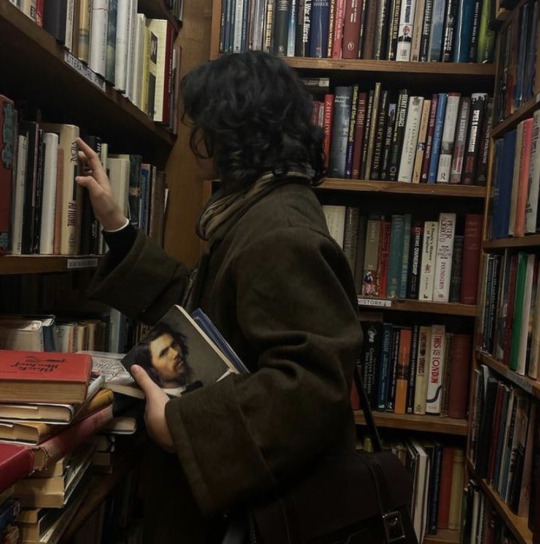

Oh who are they?
359 notes
·
View notes
Text
if you're in the throes of cosmic despair i cannot recommend museums enough. art or science or history it doesn't matter. oh we're all connected, all of us and everything, throughout all time and space, and no one, no one, no one is alone? awesome. that's what i thought i just wanted to make sure.
#museum#museums#how to work for a museum with a theater degree and no experience#i worked for a children's museum for a hot second but that doesn't count#except my badge gets me in to all the la museums for free Score
7K notes
·
View notes
Text

Lamia and the Soldier (1905) by John William Waterhouse
#art#art history#artwork#painting#history#museums#culture#vintage#curators#museum#john william waterhouse#romanticism
10K notes
·
View notes
Text
BLOW UP THEIR PHONES!!!

use this call script accordingly 👇
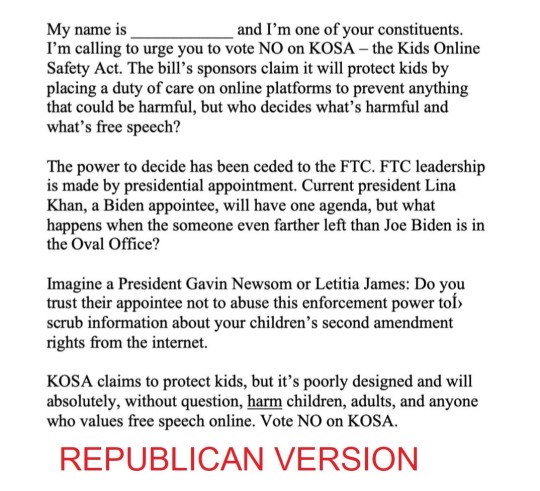

#kosa#kosa bill#stop kosa#fuck kosa#art#aesthetic#vocaloid#kaito#kaito shion#catgirl#luka megurine#catblr#gay#gay rights#trans rights#trans#lgbtq rights#LGBTQIA#dungeon meshi#figure#good omens#nancy drew#museums#anti censorship#anti kosa#fuck censorship#oc#self sona#biseuxal#panseuxal
15K notes
·
View notes
Text
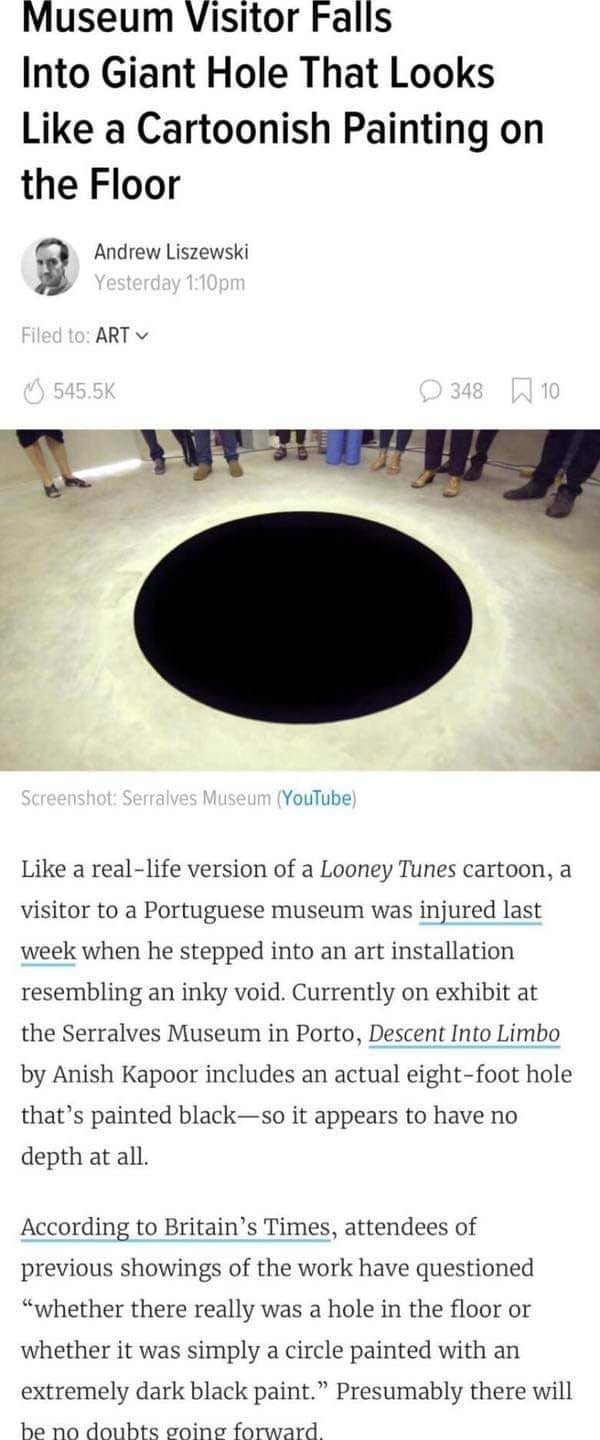
25K notes
·
View notes
Text

5K notes
·
View notes
Text

The Swamp (1900) by Gustav Klimt
4K notes
·
View notes
Text

2025.
3K notes
·
View notes
Text

-Hylas and the Nymphs-
8K notes
·
View notes
Text






Instagram credit: sarahwitpeerd
#fall aesthetic#fallblr#fallcore#autumn colors#autumn leaves#lightacademia#light academia#light academia aesthetic#dark academia#art museum#museums#artcore#art#artblr#bookblr#booklr#literature#classic literature#breakfast#photography#cambridge
4K notes
·
View notes
Text

Bouquet of Flowers (1862) by Gustave Courbet
#art#art history#artwork#culture#history#painting#museums#vintage#curators#museum#realism#flower aesthetic#flower art#floral#flowers
2K notes
·
View notes